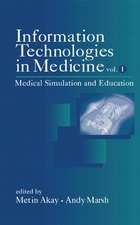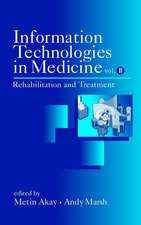Biomedical Instruments
Autor Sid Deutsch, Walter Welkowitz Editat de Metin Akayen Limba Engleză Hardback – 20 ian 1992
- Brings the volume up-to-date with new material on microprocessor applications, fiber optic instruments, and modern imaging systems
- Explains behavior of transducers
- Develops mathematical theory for transducers
- Discusses the design of biomedical instruments
- Serves as a text for biomedical engineers or a reference for medical instrument designers
- Provides suitable homework problems at the end of each chapter
Preț: 546.34 lei
Preț vechi: 575.10 lei
-5% Nou
Puncte Express: 820
Preț estimativ în valută:
104.55€ • 113.53$ • 87.83£
104.55€ • 113.53$ • 87.83£
Carte tipărită la comandă
Livrare economică 22 aprilie-06 mai
Preluare comenzi: 021 569.72.76
Specificații
ISBN-13: 9780127441511
ISBN-10: 0127441514
Pagini: 377
Ilustrații: 1
Dimensiuni: 152 x 229 x 30 mm
Greutate: 0.74 kg
Ediția:2
Editura: ELSEVIER SCIENCE
ISBN-10: 0127441514
Pagini: 377
Ilustrații: 1
Dimensiuni: 152 x 229 x 30 mm
Greutate: 0.74 kg
Ediția:2
Editura: ELSEVIER SCIENCE
Public țintă
Biomedical engineers, research workers, and seniors and graduate students in electronics engineering.Cuprins
Transducers: Analytical Methods. Passive Transducers. Piezoelectric Transducers. Ultrasonic Instruments. Electrodynamic and Magnetostrictive Transducers. Force Balance Transducers. Fiber-Optic Transducers. Signal Processing Circuitry and Microprocessors: Operational Amplifiers. Analog Filters. Data Acquisition Circuitry, A/D Converters, and Microprocessors. Biotelemetry. Frequency Discriminators and Phase-Locked Loops. Medical Imaging: Tomographic Imaging Techniques. Index.
Recenzii
"The combination of senior-level mathematics, engineering design principles, and actual biomedical instrument applications is developed in a very clear, concise, and powerful manner throughout the book. The student will gain a wealth of applied and realistic engineering design experience by studying this text...In every section of the book, each design idea is carefully developed in a clear and helpful way. The examples are relevant and timely to invoke further interest and insight into the design process...I would enthusiastically recommend the book to alll undergraduate programs in biomedical engineering." --THOMAS M. JUDD, Healthcare Technology Consultant
The key element for acquiring the physiological signal in biomedical instruments--that is, vital signs or other biomedical measurements--is a well designed transducer. The underlying theory and operational principles for many of the transducers in use in modern biomedical instruments are detailed in Part One.
Once the physiological data has been appropriately acquired, signal conditioning techniques are applied in modern instruments to convert the information to a form ready for use by equipment operators or computer interface. Part Two clearly presents most of the techniques utilized by current biomedical equipment designers.
The key element for acquiring the physiological signal in biomedical instruments--that is, vital signs or other biomedical measurements--is a well designed transducer. The underlying theory and operational principles for many of the transducers in use in modern biomedical instruments are detailed in Part One.
Once the physiological data has been appropriately acquired, signal conditioning techniques are applied in modern instruments to convert the information to a form ready for use by equipment operators or computer interface. Part Two clearly presents most of the techniques utilized by current biomedical equipment designers.















